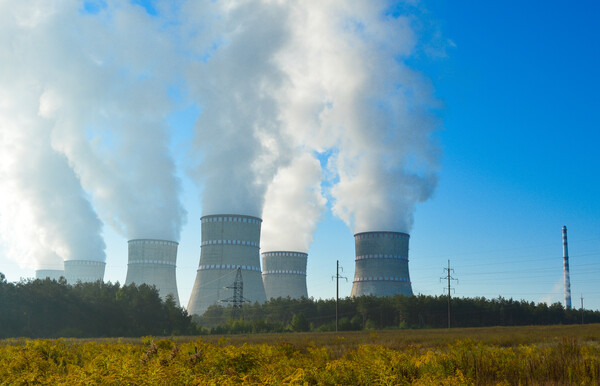Nuclear energy remains controversial as a power source—to say the least. Some say it is the solution to our energy needs, while meeting zero-carbon targets. Others say it only adds another type of problem for our environment.
Meanwhile, in the world of markets, uranium has been the hottest commodity so far in 2023 (except for orange juice). Its price has soared by 68%, jumping from about $30 per pound in the summer of 2021 to more than $80 today, the highest it’s been since 2008.
Is this just a bubble blown by speculators? The fundamentals say not. Let me explain…

Uranium Demand Growing
Output from nuclear power plants fell by 4% in 2022, largely due to an unusual number of outages in France. Overall output has remained close to the same level it has been since the early 2000s.
But that is changing.
A new conventional reactor, long delayed, has opened in Georgia, with another expected to start up soon. And existing nuclear power plants are benefitting from what amounts to a soft price-floor in the form of credits from the Inflation Reduction Act.
Elsewhere, Japan has restarted some reactors that were closed after the Fukushima accident in 2011. And, importantly, China’s rapid expansion of nuclear capacity continues. China’s latest five-year plan means there will be a 40% increase in its nuclear capacity by 2025.
However, much of uranium’s current strength relates to two factors: geopolitics and mining snafus.
Here are some examples, as pointed out by Bloomberg’s Liam Denning:
Canada’s Cameco (CCJ), the world’s second-largest uranium miner by production, recently scaled back output targets due to a variety of operating issues. Keep in mind that uranium mining is highly concentrated, with just two countries—Kazakhstan and Canada—accounting for almost 60% of overall production.
Meanwhile, a coup in the African country of Niger this summer has hampered uranium mining and processing operations in the seventh-largest producing country. Niger accounts for about 4% of mined supply, and there is a big question mark now over expansion plans there.
Then there is Russia. Before the Ukraine war, Denning relates, Russia’s strategic stockpiles and the prominent role of state-owned Rosatom in the global nuclear industry made it an important supplier of fuel to reactors worldwide. But now, Russian nuclear fuel may be cut off, at least from Western countries—but if you add Kazakhstan and Uzbekistan, countries close to Russian influence, the share of uranium purchased by U.S. and European nuclear power plants coming from these three nations is almost half.
Let’s not forget that the financial markets have also jumped in to add more fizz to uranium’s pop.
Uranium is a relatively small, illiquid market, worth only about $14 billion a year at the current spot price.
Into this market has come three listed investment funds physically backed by uranium. The largest of these is the Sprott Physical Uranium Trust (SRUUF), which just surpassed $5 billion in net asset value. Altogether, the three trusts added about 50 million pounds to their stockpiles between 2020 and 2022 as investor money flooded in—equivalent to almost 30% of the annual regular demand for uranium.
So, what does all of this mean for the future of uranium?
A Bright Future for Uranium
Nuclear power’s long-term growth prospects look good, thanks to Asia. The International Energy Agency (IEA) projects global capacity rising almost 50% by 2050, even under a conservative scenario. And the IEA sees nuclear power capacity more than doubling in a world that actually realizes its net-zero ambitions.
The U.S. Energy Information Administration (EIA) reports that, at the end of 2022, unfilled uranium market requirements for 2023 through 2032 totaled 179 million pounds for U3O8 (triuranium octoxide), the form in which uranium is sold.
Globally, looking only at nuclear power plants that are currently under construction, reactor demand is set to grow from 188 million pounds to 240 million pounds by 2030.
If every uranium-producing country gets back to its maximum output (unlikely), primary production of uranium will only grow from 140 million pounds to 174 million pounds by 2030. If secondary supply stays flat at 20 million pounds per year, the annual uranium market deficit will grow from 27 million to 45 million pounds by the end of the decade—and that figure does not include further financial buying.
The cumulative deficit between 2023 and 2030 will likely exceed 250 million pounds, possibly depleting all commercial stockpiles.
Uranium ETF
Bottom line: for the first time in history, uranium has moved into a persistent and widening supply deficit. That means—despite the price rise—it’s still a good time to get into uranium.
My preference is for a broad approach, in the form of an exchange traded fund (ETF). I like the Sprott Uranium Miners ETF (URNM), which has gained over 55% year-to-date.
Sprott is based on the North Shore Global Uranium Mining Index. Its expense ratio is reasonable at 0.83% and it is rather concentrated, with only 39 holdings, and its top three positions account for about 43% of the total portfolio:
- Cameco: 15.17%
- National Atomic Co Kazatomprom JSC ADR (NATKY): 14.63%
- Sprott Physical Uranium Trust Units (SRUUF): 13.40%
URNM is a buy anywhere under $50.
The ETF Strategy Built for a Trade War
If you’re just sitting on income from your ETFs and hoping for the best… Stop!
Tim Plaehn and Jay Soloff reveal a smarter way to use monthly ETF cash flow to protect and grow your wealth in a volatile market.





